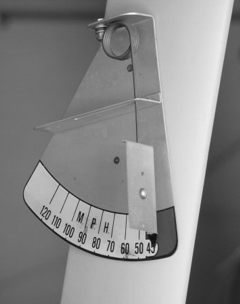|
Service
history
1943
After 1943 Tiger Moths were no longer used for primary flying
courses. Of the surviving 12 aircraft the different Air Bases had
three machines each, whilst the EMAer secured the remaining six; and
three of them were on overhaul from the beginning of the summer,
plus No 604 which, having had an accident the previous April, was
still under repair at the DGTAG&S.
|
No |
|
605 |
609 |
613 |
602 |
600 |
611 |
601 |
603 |
604 |
606 |
607 |
608 |
|
Unit |
|
BA1 |
BA1 |
BA1 |
BA2 |
BA2 |
BA2 |
EMA |
EMA |
EMA |
EMA |
EMA |
EMA |
|
Condition |
|
FO |
FO |
FO |
FO |
FO |
FO |
FO |
FO |
AOG |
AOG |
AOG |
AOG |
Condition of
Tiger Moth fleet, January 1942 (FO=
ready to flight / AOG=
aircraft on ground)
Given that the aeroplanes assigned to the Air Bases were used only
for communications duties and to maintain pilots in flying practice,
we will focus our attention on the activities developed at the
School.
|

DH 82 A
impact airspeed indicator |
At the
beginning of the year, despite having only four aeroplanes the EMAer
still had various missions assigned to the Tiger Moth fleet.
Individual aircraft were prepared for specific tasks: Nos 601 and
607 were instrument equipped for night flight; 606 was fitted with
cameras for photographic reconnaissance and 603 for target towing
whilst 604 was maintained as reserve.
As the result
of national elections a change of Presidency was realized on 1
March. As was already accepted practice, military celebrations
included an air display.
During the
previous week the aircraft destined for this were concentrated at
Pando and flew extensively for formation training.
On the first
day of the month 20 aircraft took off divided into two groups
composed of eleven Fairchild PT-19A and nine DH82A Tiger Moths. In
command of the first group and designated formation leader was the
Director of the EMAer, Major Isaias Sanchez, flying 631, whilst Sub
Director Major Gustavo Bernadou piloted 600 as the lead aircraft in
the Tiger Moth formation.
|
| |
|
No |
Pilot |
|
|
|
No |
Pilot |
600 |
May.
Gustavo Bernadou |
No |
Pilot |
| 603 |
Tte.1º
Pedro Iglesias |
601 |
Sgto.1º
Pedro Ureta |
609 |
Tte.1º
Alberto García |
| 604 |
Tte.2º
Tabaré De León |
602 |
Sgto.
Walter Alvarado |
611 |
Tte.1º
Alcides Rovira |
| 605 |
Tte.1º
Remo Laporta |
|
|
613 |
Alf.
Efraín Bacardáz |
|
de Havilland, Squadron during the air display of 1 March 1943
In January nine pilots from the National Navy had been entrusted to
the school: Marine Guards Oscar Tagle and Enrique Falco, after
undergoing instruction in the PT-19, moved rapidly on to the Tiger
Moth in June. On 10 March M/G Falcon had one dual flight of half an
hour and on the following day, after a ten minute circuit was sent
off solo in 607.
The Course for
the Junior Lieutenants who had joined the previous year, also
occupied many hours in the Tiger Moths although by then and
generally, the aircraft were flown almost exclusively by First
Sergeants and pilot instructor Sergeants from the institute.
On 17 July
after final exams a grand formation demonstration was held with 20
aircraft. Twelve PT-19As and three of the Curtiss SNC-1 were flown
by the Jr. Lieutenants of the Application Course, followed by a
squadron of five Tiger Moths piloted by junior instructors.
|
Sgto.1º Juan
Curbelo
Sgto.1º Víctor
Luciano
Sgto.1º Paulino
Risso
Sgto.1º Juan
Vonella
Sgto.1º Pedro
Ureta |
de Havilland, Squadron at the end of the course in 1943 at the EMAer
During the
second semester of the year, almost all of the activity of the Tiger
Moths based at Pando was under the command of these five. They
maintained the training routines in the Tiger Moths with frequent
local formation flights, towing the 'sausage' for firing practice by
the Curtiss SNC-1 '.30mm' and carrying out the daily administrative
missions as couriers and communicators.
Towards
November, three of the five naval officers who had begun to receive
instruction in July on the PT-19, finished this phase and moved on
to the DH82A. They were M/G Julio Rico, Adhemar Torres and Julio
Güimil, who would continue their training following the recess in
December.
At
the end of 1943, as expected, the total hours flown by
the Tiger Moths had fallen abruptly to 1,184 hours; less
than half the previous year's total.
|
| B.A.Nº1 |
B.A.Nº2 |
E.M.Aer. |
|
No |
hours |
No |
hours |
No |
hours |
| 605 |
152 |
600 |
69 |
601 |
180 |
| 609 |
124 |
602 |
143 |
603 |
49 |
| 613 |
36 |
611 |
204 |
604 |
70 |
| |
|
|
|
606 |
22 |
| |
|
|
|
607 |
107 |
| |
|
|
|
608 |
24 |
| Total |
312 |
Total |
416 |
Total |
452 |
|
Avg. |
104 |
Avg. |
138 |
Avg. |
75
|
|
|
|